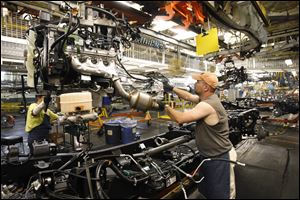
Factories roaring, but jobs still few
Ohio unemployment claims down slightly
7/1/2011
The sturdy factory activity in the automotive-heavy region snapped a string of weak regional manufacturing surveys.
WASHINGTON -- Factory activity in the Midwest accelerated in June, fostering hopes for a pick-up in economic growth in the third quarter, despite signs of lingering weakness in the labor market.
Optimism was tempered somewhat Thursday by a separate report from the Labor Department showing initial claims for state unemployment benefits slipped just 1,000 to 428,000 last week. Economists had expected claims to drop to 420,000.
Ohio reported the nation's largest decline in new applications for unemployment benefits, while the government says the number of claims nationwide is mostly unchanged. The U.S. Department of Labor said Ohio claims dropped by nearly 2,800 in the week ending June 18. No reason was given for the largest decline among states.
The Institute for Supply Management-Chicago said Thursday its business barometer rose to 61.1 after slowing abruptly to 56.6 in May.
The gain defied economists' expectations for a drop to 54.
The sturdy factory activity in the automotive-heavy region snapped a string of weak regional manufacturing surveys and raised optimism the economy may start to emerge from the soft patch it became stuck in the first half of the year.
"This may be an indication that we are at least at the bottom of this slowdown, not only in manufacturing but also economic," said Millan Mulraine, senior macro strategist at TD Securities in New York. "In the months ahead we are likely to see a resurgence in growth."
Thursday marked the 12th straight week that unemployment claims have been above 400,000, a sign the labor market has stagnated. Employment stumbled badly in May, with employers adding just 54,000 jobs -- the fewest in eight months.
The economy has been slammed by high gas prices, and supply chain disruptions in the auto sector after the March earthquake in Japan.
Many economists and the Federal Reserve, which ended its latest round of monetary stimulus Thursday, have always maintained the obstacles to growth in the first six months of the year were temporary. Still, some analysts had begun to speculate the Fed might be forced to offer further stimulus given as signs of weakness.